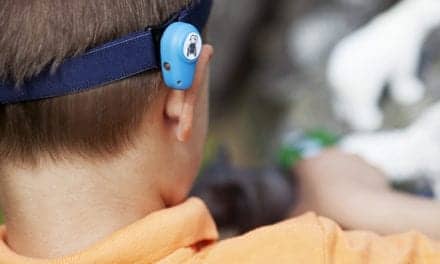Tech Topic | June 2018 Hearing Review
Two commonly cited benefits of rechargable hearing aids are ease of use and time savings. This study found it significantly (~75%) faster and easier to insert then remove the Audéo B-R from the charger case versus inserting the disposable hearing aid battery, in both the participants’ normal condition and a simulated reduced dexterity condition. The impact of simulated reduced dexterity on speed was disproportionately greater for disposable battery insertion compared with rechargeable insertion/removal.
Hearing aids require power, and traditionally have run on disposable zinc-air batteries, in part, due to limitations with traditionally available rechargeable technology. In 2016, Phonak introduced the first lithium-ion rechargeable hearing aid that delivers 24 hours of hearing following a 3-hour charge (expected results when fully charged and up to 80 minutes wireless streaming time).1 Since that time, several rechargeable systems have appeared on the market, with the overall intuitive benefits of saving time for consumers and making hearing aid use easier for some because of reduced demands on dexterity.
However, few studies have sought to quantify these benefits. In this study, we were interested to see if this new rechargeable technology really is easier to use and potentially saves time for wearers, both with normal and simulated reduced dexterity using Cambridge Simulation Gloves.2
Introduction
Kochkin3 reported that reason #10 why people were not wearing their hearing aids was because of the annoyance of needing to regularly manipulate the volume control, suggesting ease of use is an important driver of hearing aid satisfaction. Desjardins and Doherty4developed the Practical Hearing Aid Skills Test (PHAST) to evaluate the ability of hearing aid users to manipulate their devices, and found that even experienced users can find it hard to use their hearing aids.
Ease of use also relates to maintenance factors, such as cleaning and battery management. Indeed, Erber5 suggested several design changes to batteries to help alleviate common problems with handling, including rechargeable hearing aids.
More recently, results of the MarkeTrak IX (MT9)6 study showed that non-wearers rated a “rechargeable hearing aid” and “rechargeable batteries for hearing aids” as #2 and #4 in the Top-10 features that would motivate them to purchase hearing aids, respectively. This is, perhaps, not surprising given the rechargeable age we all live in, from smartphones and tablets right through to power tools and even cars! Rechargeable hearing aid technology (eg, Ag-Zn, Ni-MH) has been around for years; however, substantial limitations (eg, long charge time, short service life, insufficient power to handle streaming1) often led to selection only when dexterity clearly indicated it.
These issues are eliminated with rechargeable lithium-ion battery technology. The launch of the Phonak Audéo B-R in 2016 meant the delivery of 24 hours of hearing with one 3-hour charge.1 Rechargeable hearing aids are now being fitted to a wide range of clients.
The goals of this study were to:
1) Determine if there is any difference in the time and effort required by clients to manage rechargeable hearing aids compared to disposable hearing aid batteries, and
2) To determine the impact of simulated reduced dexterity on the time and effort required by clients to manage rechargeable hearing aids compared to disposable hearing aids.
Methods
A total of 50 participants who work within the hearing care industry were invited to participate in this activity. No participants reported any issues with dexterity. The study consisted of four conditions, as outlined in Table 1.
Condition 1 required participants to insert a disposable hearing aid battery into an Audéo B-312 (ie, remove battery from packet, remove sticker from battery, open battery door, insert battery correct way up, close battery door). Condition 2 required participants to do the equivalent with the rechargeable Phonak Audéo B-R hearing aid (ie, insert then remove the hearing aid from the charger case). Conditions 3 and 4 were a repeat of 1 and 2, respectively, except the participants were wearing Cambridge Simulation Gloves to emulate reduced dexterity (Figure 1a). Participants were timed using a stopwatch for each condition and then asked to rate the ease on a 5-point Likert scale (Figure 1b).

Figures 1a-b. Above: Author with the Cambridge Simulation Gloves. Below: 5-point Likert scale for rating ease of use.
Results
Figure 2 shows the time results for all four conditions. Without gloves, the average time taken to insert the disposable battery was 13.5 seconds compared to an average of 3.3 seconds to insert then remove the rechargeable hearing aid from the charger (rechargeable was 76% faster). When wearing the gloves, this increased to 21.6 seconds and 4.9 seconds, respectively (rechargeable was 77% faster). Use of the gloves resulted in an increase (60% for disposable and 48% for rechargeable) in the time needed to complete the task. This is consistent with reduced dexterity having more impact on managing disposable hearing aid batteries.

Figure 3. Box-Whisker plots of group ease-of-use rating data for the four conditions (1=Very Easy, 2=Easy, 3=OK, 4=Fiddly, 5=Very difficult).
Results of ease-of-use ratings are shown in Figure 3. Without gloves, the average ease-of-use rating for inserting a disposable battery was 2.6, compared to 1.2 for inserting then removing the rechargeable hearing aid from the charger case. With gloves, this increased to 4.1 and 2, respectively.
An ANOVA with two-factor replication was conducted to investigate the main effect of the Cambridge Simulation Gloves. Results showed that the gloves had a significant effect on the time taken both inserting a disposable battery into the Audéo B-312, as well as inserting then removing the Audéo B-R from the charger (f(1,48)=136.45, P<0.0001).
Post-hoc analysis using paired t-tests (with Bonferroni correction) was then performed to compare the condition of disposable versus rechargeable both in terms of time and ease of use. Results show significant differences between the time taken to insert a disposable battery versus inserting then removing the Audéo B-R from the charger (P<0.0001). Participants also rated it significantly easier to manage the rechargeable action versus insert the disposable hearing aid battery (P <0.0001). No relationships were found between ease-of-use ratings and time measures across any of the conditions, possibly due to use of only a 5-point Likert rating scale.
Regression analysis was also performed (Figure 4) to further explore relationships between disposable and rechargeable, as well as the impact of gloves. For disposable batteries (Figure 4a), those faster without the gloves tended to be faster with them (P <.0001); however, as indicated by the slope of the linear regression function (0.5456), their times were affected more by wearing the gloves. For rechargeable (Figure 4b), those faster without the gloves also tended to be faster with the gloves (P<0.0001); however, the increased time was proportionately less and more uniform (as indicated by slope of line close to 1.0).

Figure 4a-b. Regression analysis comparing: A) The time taken to insert a disposable battery with versus without the gloves and B) The time taken to insert them remove the rechargeable hearing aid from the charger case with then without the charger case. The dashed grey line is the line of best fit by linear regression. Both relationships are significant (P<.0001). The orange dashed line represents unity.
Discussion
The results show that, either with or without the Cambridge Simulation Gloves, participants were significantly (~75%) faster and rated it significantly easier to insert then remove the Audéo B-R from the charger case than insert a disposable battery in to the Audéo B-312. The impact of the gloves was proportionately greater for disposable batteries, consistent with reduced dexterity having more impact on managing disposable hearing aid batteries.
This is precisely the use rechargeable hearing aid technology has traditionally been reserved for; however, these data show significant benefits for people with normal dexterity too. Intuitively, those faster without the gloves were faster with them, and this was true for both disposable and rechargeable battery technology. Interestingly, for disposable batteries, gloves had a greater impact on those faster without them versus those who were slower without them. This might be because those faster without gloves rely on their good dexterity and when this was constricted they found this disproportionately more debilitating than those who were slower without gloves. Alternatively, those slower without the gloves were simply taking a bit more time anyway and, therefore, were less affected by the gloves. However, for rechargeable technology, the impact of gloves on speed was more consistent (and proportionately less than for disposable).
No relationships were found between ease-of-use ratings and time results, possibly due to the use of a discrete, 5-point Likert scale. Potential areas for improvement in study design are: 1) Using a continuum and measurement scale in order to further explore and quantify subjective impact; 2) Including timing of the removal of an old battery before inserting a new battery; 3) Including the time taken to switch the respective devices on then off, as this is also required each day.
Summary
We invited 50 people who work in the hearing care industry to insert a disposable hearing aid battery into a Phonak Audéo B-312. Then they were asked to insert and remove the hearing aid into and out of the charger case. They were then asked to repeat these two tasks wearing Cambridge Simulation gloves2 to emulate the effects of reduced dexterity.
The results support selection of rechargeable technology for clients with all levels of dexterity to facilitate faster and easier power management for their hearing aids.
Managing rechargeable hearing aid technology is significantly faster (~75%) and rated significantly easier to handle than inserting disposable batteries by participants with both normal and simulated reduced dexterity (using the Cambridge Simulation Gloves). Hearing aids with lithium-ion rechargeable battery technology address the need for ease of use to facilitate increased user experience / satisfaction. If clients have current dexterity issues or are likely to develop dexterity issues in the future, these results suggest that integrated, lithium-ion rechargeable battery technology is a good safeguard for future handling.
Acknowledgements
The author thanks Grant Searchfield at the University of Auckland for assistance with statistical analysis, and Davina Omisore for support with the Cambridge Simulation Gloves. Additionally, thanks to Winner Tian and Fabian Straube for help with data collection.
Correspondence can be addressed to HR or David Crowhen at: [email protected]
Citation for this article: Crowhen D. Rechargeable batteries: A study of time savings and ease of use. Hearing Review. 2018;25(6):24-26.
References
-
Hirchak D, Omisore D. Phonak Insight: Phonak rechargeable hearing aids. September 2016. Available at: https://bit.ly/2rR82PM
-
University of Cambridge. Cambridge simulation gloves. http://www.inclusivedesigntoolkit.com/gloves/gloves.html
-
Kockhin S. MarkeTrak V: “Why my hearing aids are in the drawer”: The consumers’ perspective. Hear Jour. 2000;53(2)[February]:34-41.
-
Desjardins JL. Doherty KA. Do experienced hearing aid users know how to use their hearing aids correctly? Am J Audiol.2009;18[June]:69-76.
-
Erber NP. Use of hearing aids by older people:Influence of non-auditory factors (vision, manual dexterity). Int J Audiol. 2003; 42(Sup2):2S21-25.
-
Abrams HB, Kihm J. An introduction to MarkeTrak IX: A new baseline for the hearing aid market. Hearing Review. 2015;22(6):16.









